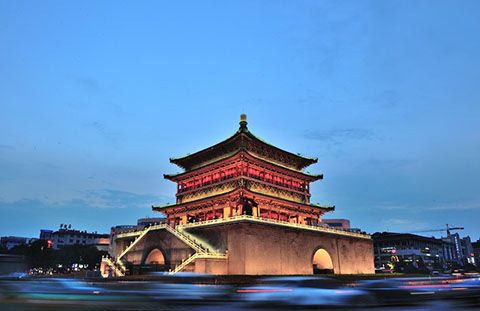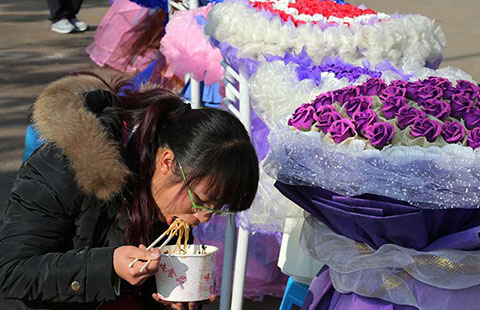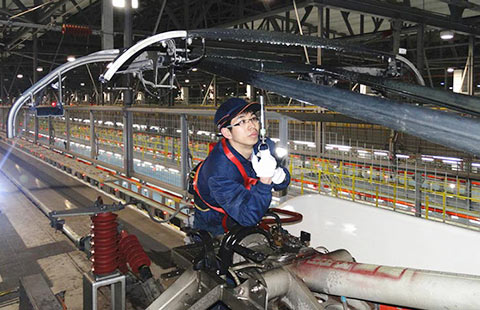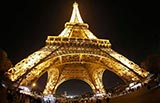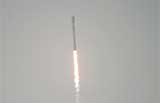Manufacturing sector still struggling in H2
By He Wei in Shanghai and Sophie He in Hong Kong (China Daily) Updated: 2012-09-06 09:30China's lackluster manufacturing sector will continue to struggle in the second half of the year, a newly released government report said, threatening to deprive the world's biggest manufacturing hub of a growth driver.
The sector will continue to be hit by the significant domestic slowdown, the lingering pain of the eurozone crisis and the anemic recovery of the US economy, according to the report compiled by the Ministry of Industry and Information Technology and the Institute of Industrial Economics of the Chinese Academy of Social Sciences.
The forecast was released just days after the country's leading indicator for the manufacturing sector hovered around a nine-month low in August, putting renewed pressure on policymakers to do more to boost growth.
Industrial output in the first seven months of the year maintained a moderate 10.3 percent year-on-year growth rate, the report said. But readings from April to July were all below 10 percent.
The declines were widely seen among major industries across the nation. Overall profits in the first seven months were at 2.68 billion yuan ($422 billion) in the first seven months, down 2.7 percent year-on-year.
Export figures in July posted the sharpest annual drop since 2009, in line with the trend seen in the first half. Exports climbed just 1 percent, a slide of 10.3 percentage points from June, casting doubts on the prospects of the export-driven model.
Breaking down the data by industries, the China Iron and Steel Association said that one-third of its member companies are running in the red. The sector achieved a mere 700 million yuan in net profit from January to July.
China's steel production industry has an overcapacity of about 25 percent due to the weakened demand, said Standard & Poor's credit analyst Suzanne Smith.
Smith said that steel consumption in China used to increase at a very fast pace, but that the demand growth has slowed this year along with property development and fixed-assets investment. The change in demand has increased steel inventories, dragging down the prices, she noted.
For example, China's biggest listed steelmaker Baoshan Iron & Steel Co Ltd said recently it would slash the prices of its main products for September bookings by up to 3.4 percent, the third reduction in a row since June, indicating a lack of market confidence in the short term. Meanwhile, China's shipbuilding industry has shadowed the global recession for the last three years.
The country built ships amounting to 35.49 million deadweight tons, down 7.7 percent from the previous year. New orders totaled 11.64 million deadweight tons, half of the figure from a year earlier. Combined outstanding orders were 123.48 million deadweight tons, down 17.6 percent from the end of 2011.
Many small-sized shipyards, plagued by a shortage of new orders, are on the brink of bankruptcy as a result of the sluggish global economy, a glut of vessels and soaring fuel prices.
The only sector that showed a more promising performance is the electronics and home appliances sector. The value of exported electronics products increased 10.7 percent year-on-year, a growth pace faster than in most other industries.
Sales of appliances rebounded to double-digit growth, largely fueled by energy-efficient subsidy policies and a program to sell home appliances to rural populations, said Xie Jiyong, an analyst with Capital Securities Corp in Shanghai.
The lackluster manufacturing sector report also came amid shrinking factory activity in almost every major economy.
Japan's official industrial output dropped 1.2 percent in July following a 0.4 percent gain in June, while a measure of US manufacturing activity ticked down from 49.8 in July to 49.6 in August, according to the Institute for Supply Management in the US.
Zhou Hao, an economist at Australia & New Zealand Banking Group Ltd, recently cut the forecast for China's 2012 GDP growth to 7.8 percent from 8.3 percent. He said he believes that the decline in the inventories of both materials and new orders show that corporate demand remains sluggish.
While investment has failed to unlock the full potential of consumer spending, Wang Tao at UBS said he believes that the government's goal of 7.5 percent growth is likely to be reached, but that downside risks remain due to policy delays.
Beijing has been highly cautious of large-scale stimulus plans for fear of putting short-term economic growth ahead of sustainable development and triggering a new round of inflation.
hewei@chinadaily.com.cn
- Despite falling sales, experts raise a glass to celebrate wine
- Chinese shares dive 2.84% at opening Monday
- Donkey skin sector needs tonic of supply
- Western brands keen to cash in on students
- China to approve its first sound trademark
- Chinese companies boost operations in Egypt
- From farm to dining table, food takes Web route to success
- Investors anxious as markets reopen

